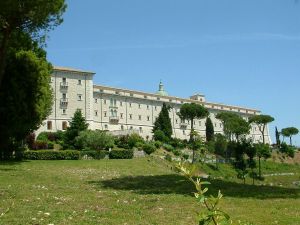My late mother’s cousin Sarkis and his wife Margaret arrived at “Tre Cancelle” for a fortnight’s stay. We were really looking forward to seeing them, as three years had passed since we had last got together, and we always much enjoyed their good company. During their stay we took them out and about locally and they visited both Rome and Pompei. However they also kindly insisted in helping us to make a start at clearing up the mountain of olive prunings that littered our groves.
On the Sunday afternoon we were invited to meet up with “The Family” in Atina. However first we drove up the steep and tortuous road that steadily winds its way up to the summit of Montecassino. From here there are splendid views of the town of Cassino below and of the surrounding mountains and valleys. The Abbey we have now visited on several occasions, yet I still find myself in awe of the history and grandeur of the place. The monastery was founded by San Benedetto in 525 and was renowned through the ages as a place of holiness, culture and art.
During the final stage of World War II, Montecassino lay on the firing lines between the Germans and the advancing Allied Forces. The Germans had set up a defence line known as the GUSTAV Line, and Montecassino formed one of its most potent strongholds. The mountain dominates the surrounding countryside including the Liri Valley that runs through the mountains to the North, and the main road that links the South with Rome and in addition provided a perfect crow’s view of the town of Cassino below. The Allied governments accused the Germans of using the Monastery as a stronghold, which the Germans categorically denied. However, the tenacious Germans were well dug into caves that they had been blasted into the rock on the slopes of the mountain.
The town of Cassino was first bombed on the 10th September 1943 when targets along the Garigliano River were hit. This caused heavy civilian casualties, and some local people took refuge in the Monastery. The next assault on the Cassino Front was planned for the 15th February 1944. Many local people once again took refuge in what they believed to be the sanctuary of the Abbey. The bombing then began in earnest. In three hours of bombardment the monastery was reduced to a heap of rubble and ruins and many Italians met their death. Two of my mother’s cousins were killed during the bombing of nearby Atina. Soon there was uproar from all round the world at the destruction of this holy bastion.
The fighting at Montecassino continued to rage for several months, and many more lives were lost before the Allies finally captured the German positions. Montecassino was finally liberated on the 18th May 1944, and the Allies could then continue their march towards Rome. After the war the Abbey was rebuilt according to its original design, and brought back to its former glory, the reconstruction and decoration works taking more than a decade to complete. In all, more than 30,000 soldiers lost their lives at Cassino and many are buried there in the nearby British, French, Polish, German and Italian Military Cemeteries.
Later we drove down to the foot of Montecassino to find the British Commonwealth War Graves Cemetery, the grounds of which are lovingly and meticulously tended in memory of the fallen soldiers. Here in this tranquil sanctuary more than 4200 brave young men now slumber in eternal peace, overlooked by the abbey from aloft.
Click Here To Read another Blog Entry Regarding The Battles Along The Gustav Line
Click Here For More information about Cassino and Montecassino and surrounding area
~~~~~~~~~~~~~~~~~~~~~~~~~~~~~~~~~~~~~~~~~~~~~~~


